The LA fires burned a lot of lithium-ion batteries. What does that say about a clean energy future?
Lithium–ion batteries have been making headlines since the devastating Eaton and Palisades fires broke out a month ago.
From concerns about evacuating in an electric vehicle, to the challenges of cleaning up these batteries, we spoke with experts about how society grapples with worsening disasters largely fueled by the use of fossil fuels, while investing in new technologies that also bring new challenges.
Should you evacuate in an electric vehicle?
Short answer: it depends.
If you’re evacuating a long distance away, a gas car may be the right choice, since electric charging infrastructure is more sparse, and you can take an extra can of gas with you.
But if you’re stuck in traffic as everyone evacuates at once — a common occurrence during wildfires here in California — an electric vehicle may actually be your better bet.
“The EV has a decent chance of getting you farther than the gasoline powered car [in traffic], because it uses a lot less energy at low speeds and at very low speeds, compared to a gas vehicle,” said Jamey Wetmore, associate professor in the School for the Future of Innovation and Society at Arizona State University. Wetmore has written about the pros and cons of evacuating in a gas versus an electric vehicle.
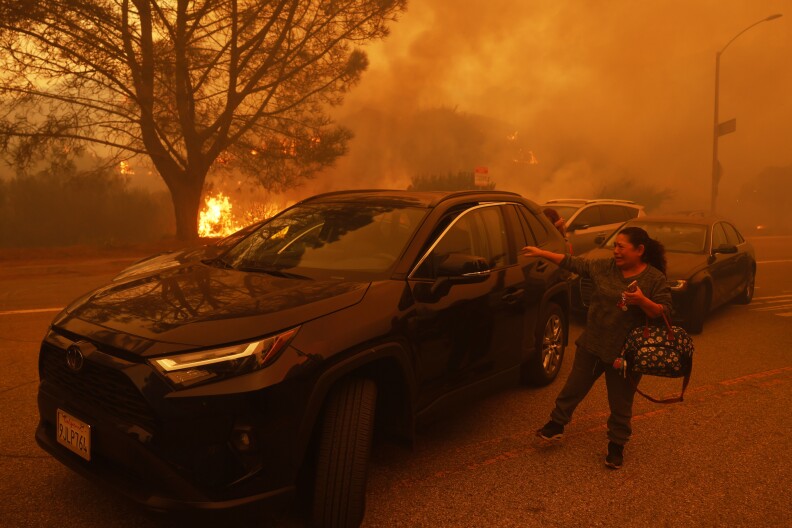
A woman cries as the Palisades Fire advances in Pacific Palisades on Jan. 7, 2025.
Etienne Laurent
/
AP
)
Keep in mind that when the power goes out, gas stations can’t pump gas either, unless they have a backup generator.
That’s something Scott Tallal learned the terrifying way when he and his wife evacuated their Malibu home in a hybrid vehicle during the 2018 Woolsey Fire. A drive down the mountain that usually took about 25 minutes, took five hours.
”We saw the gas gauge dwindling by the minute,” Tallal said. “We got to the first gas station, which was 3 miles from our house, and they were not able to pump gas. The power was out.”
Tallal said they now have a fully electric Hyundai Ioniq, which they used when they had to evacuate again during the Palisades Fire.
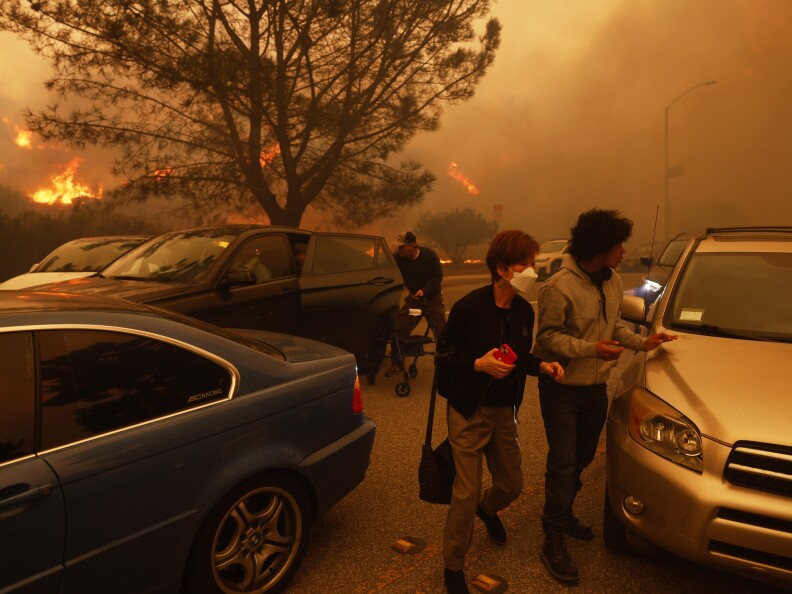
People flee from the advancing Palisades Fire, by car and on foot, in the Pacific Palisades neighborhood of Los Angeles.
Etienne Laurent
/
AP
)
”We were not stressed at all about getting out of the fire risk zone because we didn’t have to stop at a gas station to refuel,” Tallal said.
They only had about 25% charge on the car, which gives them about 90 miles, Tallal said.
“It didn’t matter that we were sitting in stop and go traffic,” he said. “It didn’t matter that all of the gas stations had their power shut off between here and Woodland Hills. Even with the air on, the electric use is so minimal, the braking pretty much keeps your charge at the same level the whole time.”
Tallal said he thinks they only used about 5% of the battery going from Malibu all the way out to Woodland Hills, which is where he and his wife found a hotel.
Whether you have a gas car or EV, the most important thing is to plan ahead: know your evacuation route and where gas stations and EV charging stations are on the way, and always keep your car gas tank or battery halfway full. And it’s best to leave early — don’t wait for an order.
Do more EVs and home battery systems make wildfires harder to fight?
The Eaton and Palisades fires burned more lithium-ion batteries from electric vehicles and home energy storage systems than ever before, according to the U.S. Environmental Protection Agency, which is overseeing cleanup of the batteries.
But fire experts told LAist there is no conclusive research on how more of those batteries actually affect the intensity of the fires themselves. Firefighters say the extreme winds made last month’s fires largely impossible to fight regardless of fuel sources. And already, our urban landscape is extremely flammable.
Still, from cell phones, to power tools, to cars, lithium-based batteries are more prevalent than ever and create a new fuel source. Jonathan Torres with the L.A. County Fire Department said they do yearly training on fighting lithium-based battery fires, which burn a lot longer and are harder to put out than traditional combustible fuels, such as gas, diesel and propane.
“ If you add lithium to a fire, does it make it worse? I absolutely think so,” Torres said. “If you introduce materials that are combustible and or pose explosion hazards, it absolutely makes it more difficult.”
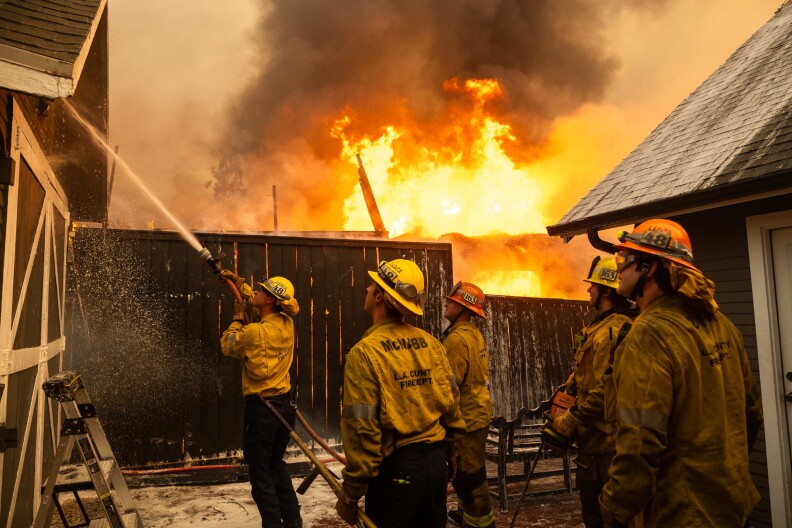
Firefighters spray water onto a burning property in Altadena.
Brian Feinzimer
/
LAist
)
But, Torres added, the fact is that much of what is in our homes — outside of lithium — is very flammable already. And much of it is petroleum-based, from paint to the material of the building itself, to plastics and gas lines.
”It’s a lot of plastic petroleum-based products that are extremely, not only flammable, but toxic,” Torres said. “That’s where you start seeing that black smoke… If [materials] are petroleum at base, they’re more susceptible to fire.”
The new challenge with lithium-based batteries is that they require a lot more water to control, said Alan Murray, director of the Wildfire Resilience Initiative at UC Santa Barbara.
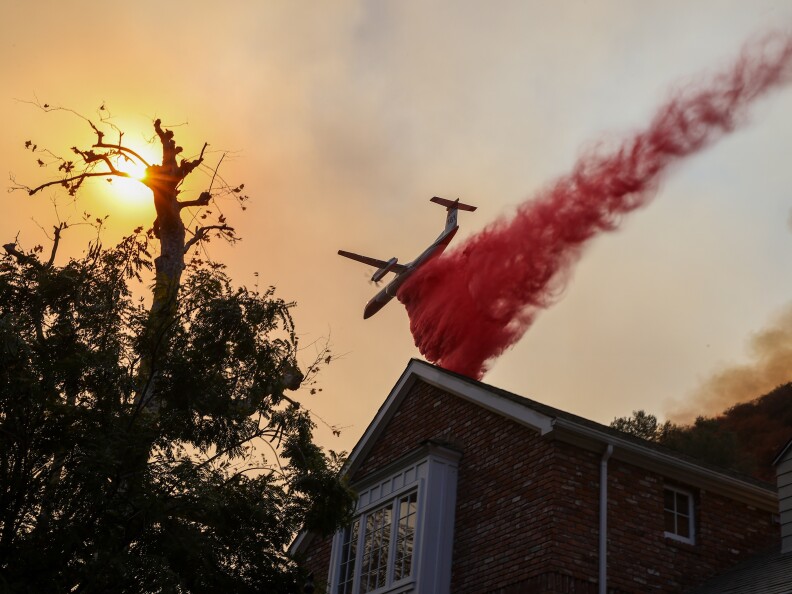
Saturday, Jan. 11: A plane drops pink fire retardant near the Brentwood neighborhood in Los Angeles, Calif.
Tayfun Coskun
/
Anadolu via Getty Images
)
“Ten times more [water] by some estimations,” Murray said. “And further, the water isn’t to put out the flame, but rather to contain the flame and then let it burn out on its own. So really, the water’s being applied so that it doesn’t spread to other battery cells.”
And that’s changing how we think about fighting fires.
“In our urban spaces, where hydrant systems are not necessarily designed to fight a full neighborhood that’s on fire, I think one emerging issue with electric vehicles is that the current way to put out an electric vehicle or lithium-based battery fire is to use a high volume of water,” Murray said.
In the Eaton and Palisades fires, hydrants ran dry not due to a lack of water, but due to the intense strain on a system not set up to fight such large-scale fires.
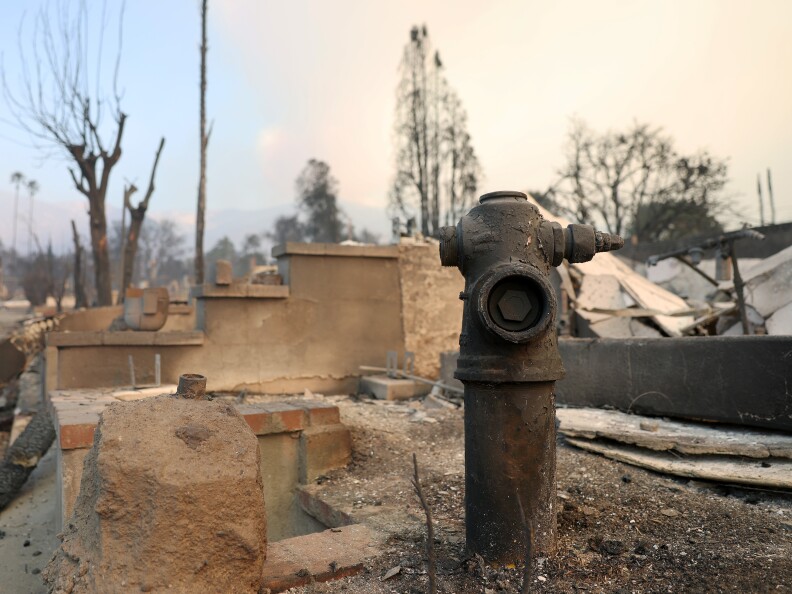
Many conspiracies involve water hydrants. The water systems used to fight the Palisades and Eaton fires couldn’t maintain the continuous high water pressures needed, meaning water stopped flowing in some hydrants.
Justin Sullivan
/
Getty Images
)
At the same time, Murray noted, while lithium battery fires tend to make headlines, research has found that electric vehicles are actually far less likely to catch fire or spark a fire than gas-powered cars — and that’s per mile traveled, not because there are fewer EVs on the road.
”Over the course of history, we’ve had introductions of new technologies that have had extremely high fire risk and fossil fuel-based internal combustion engines is certainly one of them,” Murray said. “In fact, firefighters in Santa Barbara County would say that many of our ignitions are started from [gas] cars due to the heat from catalytic converter tailpipe fumes. So, just putting EVs into perspective, there are other things that exist in our wildland urban interface that are still very risky from a fire vulnerability perspective.”
New challenges to clean up burned lithium-based batteries
The EPA has never had to clean up this many lithium-based batteries, said Chris Myers, the agency’s lithium-ion battery tech specialist for the Eaton and Palisades fires cleanup.
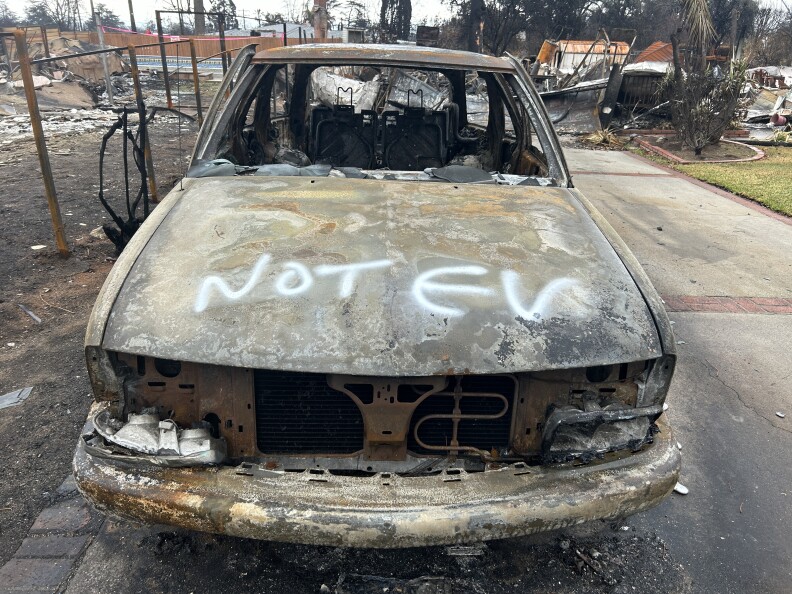
The EPA has been marking cars that are not electric vehicles as they work to remove hazardous materials from properties burned by the Eaton and Palisades fires. This is a car marked in Altadena.
Erin Stone
/
LAist
)
Unlike gas, diesel and propane, which explodes and burns up during a fire, lithium-based batteries stick around. That’s because they have thick armor to protect them during normal use, but once that’s destroyed, the batteries are at high risk of “thermal runaway,” which can cause them to reignite, Myers said.
What to do if you have burned lithium batteries on your property
The EPA is still working to clear hazardous debris, including lithium-ion batteries, from the Eaton and Palisades fire burn zones. You can call their hotline if you know your EV or home battery storage system, or other lithium-based batteries burned on your property.
- The hotline number to report lithium-ion batteries is (833) 798-7372.
- You can also find if the EPA has already cleaned your property via this map.
- Learn more about lithium battery safety after the fires here.
When burned, these batteries also release toxic vapors such as hydrofluoric acid and can leach toxic heavy metals into the ground. (Keep in mind that lead, asbestos and other toxic gases and substances are released from all kinds of other hazardous materials in burned homes). EPA workers have been collecting these batteries in sealed drums, then bringing them to staging areas where, if they still hold a charge, they’re put in a saltwater brine solution.
”That will slowly discharge the energy from those batteries,” Myers said.
Then the batteries are crushed, and eventually sent to a recycler who can salvage the critical minerals in them. Myers said all of the lithium-ion batteries collected by the EPA after the 2023 Maui fires were recycled.
[embedded content]
The large volume of lithium-ion batteries from last month’s fires has led to some backlog at the permitted recycling facilities the EPA uses, Myers noted. He said the agency will go through a competitive bidding process with these facilities before choosing the final destination of the debris.
“It’s understanding the challenges that come with [lithium-ion batteries] and getting up to speed with solutions quickly,” Myers said. “It’s just energy storage, just as petroleum fuels were in the past. And just as there will be something else in the future.”
Considerations during the rebuild
Experts LAist spoke with say the new risks and challenges that these batteries pose shouldn’t be a deterrent for adopting the technology, which the vast majority of scientists agree is key to reducing air pollution and society’s reliance on fossil fuels, as well as improving resilience in the face of more extreme heat and wildfire.
But already, certain climate resilience policies are being waived in the effort to speed up rebuilding efforts — L.A. Mayor Karen Bass waived the requirement for all-electric new construction in the Palisades Fire area, which would reduce the use of flammable gas in a high-risk fire zone.
“It’s short-sighted,” said Denise Grab, project director for UCLA’s Emmett Clean Energy Law and Leadership Project. “The solar and storage requirements that are in the law help create more resilient homes in the face of disasters like this in the future.”
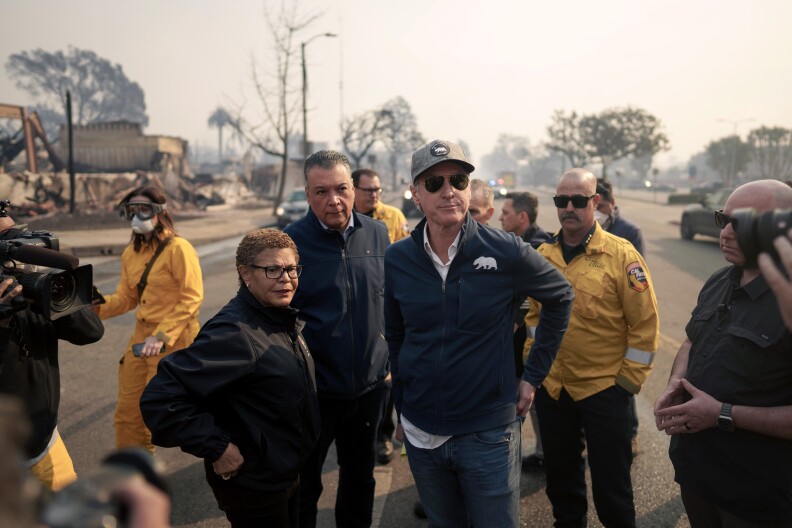
California Gov. Gavin Newsom and Los Angeles Mayor Karen Bass tour the downtown business district of Pacific Palisades as the Palisades Fire continues to burn on Jan. 8, 2025 in Los Angeles.
Eric Thayer
/
Getty Images
)
Wayne Alldredge, an engineer with Servi-Tek Facility Solutions and technical advisor for the US Green Building Council chapter in Los Angeles, said battery technology for cars and home energy storage is constantly improving and getting safer.
“Not all batteries are the same,” Alldredge said. “Not all lithium batteries propagate fire. You can’t vilify an entire industry based on a few chemistries.”
He pointed to lithium iron phosphate batteries, or LFP batteries, which tend to be heavier, but are safer and ideal for home battery systems.
“ I chose it specifically because I know the chemistry is safer, so it doesn’t propagate flames,” Alldredge said.
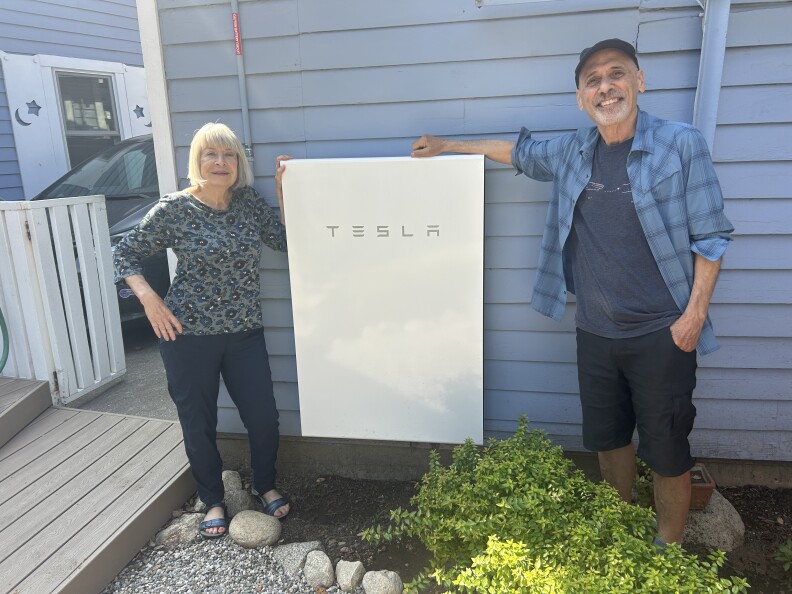
Sierra Madre residents Teresa and Joe Tortomasi stand beside their 13 kilowatt hour battery, which stores energy from their solar panels to support their whole home, and can also offload excess power to the broader power grid.
Erin Stone
/
LAist
)
Though the causes of both fires are still under investigation, many in California have been started by power lines — and that is being investigated as a cause of the Eaton Fire. Alldredge said these home battery systems are not only more fire-safe and efficient than traditional gas or diesel generators (plus they don’t pollute the air), they can also help with resilience as more extreme heat and wildfire risk affects the broader grid.
“If everybody had a home grid that was solar-powered with batteries on their own homes, that fire may never have started,” Alldredge said.
And if more people had backup power, it would be less of a disruption if utilities have to turn off power due to fire risk, Grab said.
“Almost all ways to store and use energy involve some risk,” Grab said. “The status quo has its own dangers. Burning these fossil fuels not only causes climate change, but creates air pollution that causes lung and heart disease and even premature death. We need to look for other alternatives that may be less toxic over time, but lithium batteries are a vital tool to address the dangers of climate change and air pollution.”
Gas appliances in homes and businesses are responsible for more than 10% of California’s planet-heating emissions. Research has also found that appliances such as gas stoves, leak a lot of health-harming chemicals, including carcinogens like benzene.
Grab pointed to how other communities and states have incentivized energy-efficient electric rebuilds in the wake of fires: after the 2017 fires in Northern California, Sonoma and Mendocino counties offered incentives for people who lost their homes to rebuild with energy efficiencies, including solar and storage.
In Washington state, lawmakers had considered eliminating building code electrification requirements for victims of the 2023 wildfires, but instead created a fund to help support them to rebuild more resilient, all-electric homes. There were similar incentive efforts after the Marshall Fire in Colorado.

